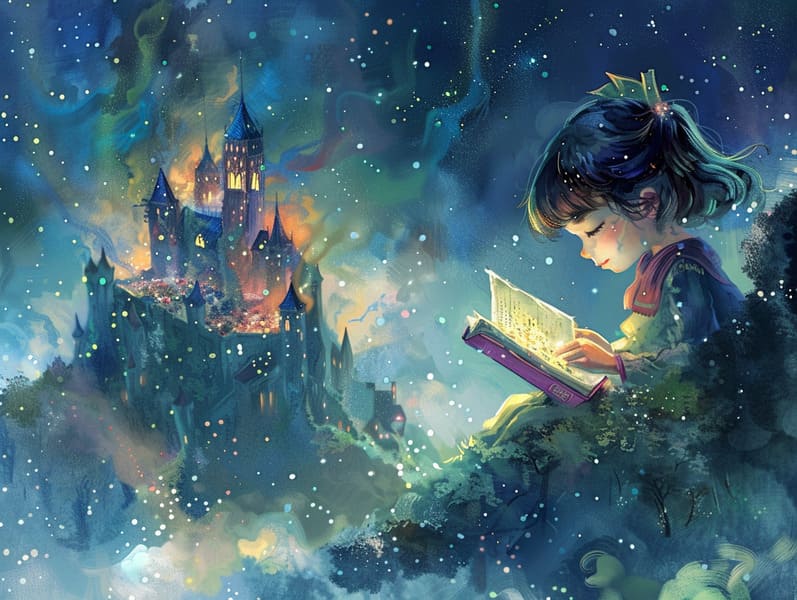
Famous fairy tales have old origins. These narratives have been conveyed from one generation to the next ages before they were ever recorded. They came from a variety of cultures, including Asian traditions. They were initially disseminated among elders, often carrying themes and messages concerning the societal norms and beliefs of the time.
The Grimm brothers, Jacob and Wilhelm (the Grimm brothers), were among the first to gather and publish many of these beloved fairy tales. Their published works, "Grimm's Fairy Tales," included classics like "Cinder Maid," "Hansel and Gretel," and "Little Snow White," which have since become mainstays in the world of timeless fairy tales. Similarly, Hans Andersen's delightful stories, such as "The Mermaid's Tale," and "The Duckling's Story," have captivated hearts worldwide, cementing their place in the pantheon of famous fairy tales.
Despite their age, fairy tales remain as pertinent as ever, especially as kids' bedtime tales. These delightful tales are now available in numerous formats, including vibrantly illustrated books, fantastical animations, and web-based fairy tales.
Their enduring popularity can be traced to several charming aspects:
Ethical Lessons: Classic fairy tales often impart important moral lessons. Stories like "The Story of the Boy Who Cried Wolf" teach the benefit of honesty, while "The Race of the Tortoise and the Hare" highlight the qualities of persistence and humbleness. These tales offer kids clear distinctions between correct and incorrect, helping to shape their moral compass in a tender yet impactful way.
Warmth and Understanding: Old fairy tales frequently present heroines facing difficulties and adversities, urging readers to comprehend with their struggles and celebrate their triumphs. For instance, "The Tale of Beauty and the Beast" illustrates the virtue of appreciating inner worth to acknowledge the true essence of a character, nurturing warmth and comprehension.
Cultural Insights: Many fairy tales are deeply embedded in the cultural contexts from which they emerged. Exploring these stories can provide fascinating glimpses into different customs, cultivating a sense of cultural insight and perception.
Imagination and Creativity: The mythical elements in timeless fairy tales—wizardry and magic—promote children’s creative minds. These tales carry readers to fantasy realms, enhancing innovative thinking and a sense of delight that stays a lifetime.
Ancient fairy tales are not only fantastical but also edifying. They provide delightful tools in promoting various mental and emotional abilities in young ones. When ancient fairy tales are read aloud, they promote speech development by bringing new language and elaborate sentence structures. This practice also nurtures auditory perception and mindfulness, as children hang on every word, enthusiastic to see what happens next.
Furthermore, reflecting on the themes and characters of fairy tales can strengthen logical thinking and thought processes. The young are led to see patterns, guess what will happen, and comprehend cause and effect. These explorations also benefit the young reveal their thoughts and feelings, promoting their emotional intelligence.
In today’s technological era, the abundance of online storybooks has made these narratives more within reach than ever. Web-based platforms best fairy tales to read online and applications supply huge assortments of bedtime fairy tales that can be explored or listened to anytime, anywhere. Fairy tales voiced are particularly well-received, providing an charming way for kids to immerse in these delightful tales. Read-aloud stories and narrated videos take characters and settings to life, often joined by mesmerizing audio effects and soundtracks that intensify the narrative adventure.
The enduring charm of timeless fairy tales lies in their ability to modify to modern society while staying true to their underlying messages. Contemporary renditions of these fairy tales often present more varied figures and modern settings, making them relevant to today’s audience. However, the core values of guts, understanding, and even-handedness remain unchanged, continuing to touch young listeners of all ages.
Fairy tales also offer a sense of familiarity and recognition. They highlight a well-arranged narrative with a plain beginning, middle, and end, often coming to a close with the closure of conflicts and the triumph of morality over wickedness. This predictability can be encouraging for the young, yielding a sense of unwaveringness in an dynamic world.
Traditional fairy tales continue to fascinate and teach new generations, maintaining their grace and pertinence in modern society. As children's bedtime stories, they serve a perfect blend of captivation and insight, enhancing moral values, empathy, and creativity. The proliferation of free fairy tales online and the prevalence of fairy tales spoken confirm that these old tales remain acquirable to new generations.
By continuing and disseminating these narratives, we continue to honor the rich tapestry of creativity and cultural heritage. Whether you are accessing a beautifully illustrated book, perusing a internet collection, or listening through an narrated book, the allure of timeless fairy tales is always within reach. These narratives demonstrate of the consistent effect of tales and its ability to bring us together across time and space.
Regardless if you are discovering a gorgeously illustrated book, seeing a electronic library, or listening to an read-aloud story, the mystique of ancient fairy tales is always within reach.
These stories convey of the unceasing strength of fairy tales and its ability to join us across centuries and lands, weaving a spell that enchants and educates alike.